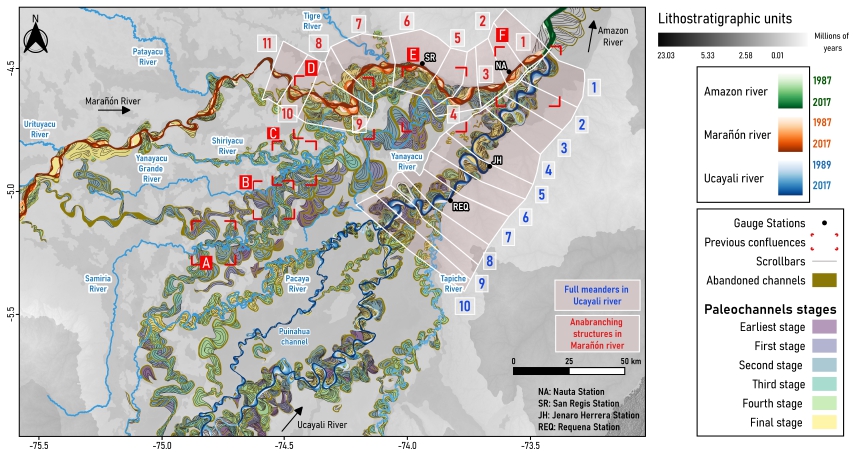New Publication: Hydrogeomorphology of the origin of the Amazon River, the confluence between the Marañón and Ucayali rivers

Cover figure: Ancient confluences along the Ucamara depression. Figure from Guerrero et al. (2024)
In our recent publication, “Hydrogeomorphology of the origin of the Amazon River, the confluence between the Marañón and Ucayali rivers”, the hydrodynamics, sediment transport, bed morphology and planform morphology of one of the most dynamic confluences in the world are presented. The Ucayali River has shifted significantly along the Ucamara depression and joined the Marañón River all over Pacaya-Samiria, showing ancient confluences, that´s why studying the present, we want to understand the past.
Methodology
Using a combination of remote sensing techniques, hydro-geomorphological measurements and interpretation of physical processes around the confluence of the Marañón and Ucayali rivers. The characterization of modern river dynamics followed the methodology presented by Abad et al (2022), Abad et al (2023). The ancient river dynamics were extracted from Rojas et al (2023).
The hydro-geomorphological measurements made it possible to obtain detailed three-dimensional hydrodynamics and sediment transport processes (suspended and bedload), as well as the bathymetry of one of the most dynamic confluences in the world.
Results
Results showed that meandering-meandering confluences existed when bifurcated meandering channels from the Marañón River joined the meandering Ucayali River, and far-field scale provided the boundary conditions for the near-field scale processes. In the case of the Marañón River, the spatial frequency and displacement of incoming anabranching structures to the confluence location set the boundary conditions for the near-field scale. In the case of the Ucayali River, the incoming hydrodynamics and bed morphology are governed by far-field processes such as the occurrence of cutoffs.
In addition, high intensity secondary flows at large rivers were observed at far- and near-field scales, where previous studies have reported that secondary flows are weak or nonexistence or mainly found downstream of confluences. Finally, even though the Marañón River is larger compared with the Ucayali River, the confluence hydrogeomorphology is governed by the Ucayali River because of more developed and stronger secondary flows.
Citation
Guerrero, L., Abad, J.D., Ortals, C., Valderde, H., Estrada, Y., Chicchon, H. Marin, J., Canas-Alva, C. (2024) Hydrogeomorphology of the origin of the Amazon River, the confluence between the Marañón and Ucayali rivers. Earth Surface Processes and Landforms, 1–19. https://doi.org/10.1002/esp.5949
